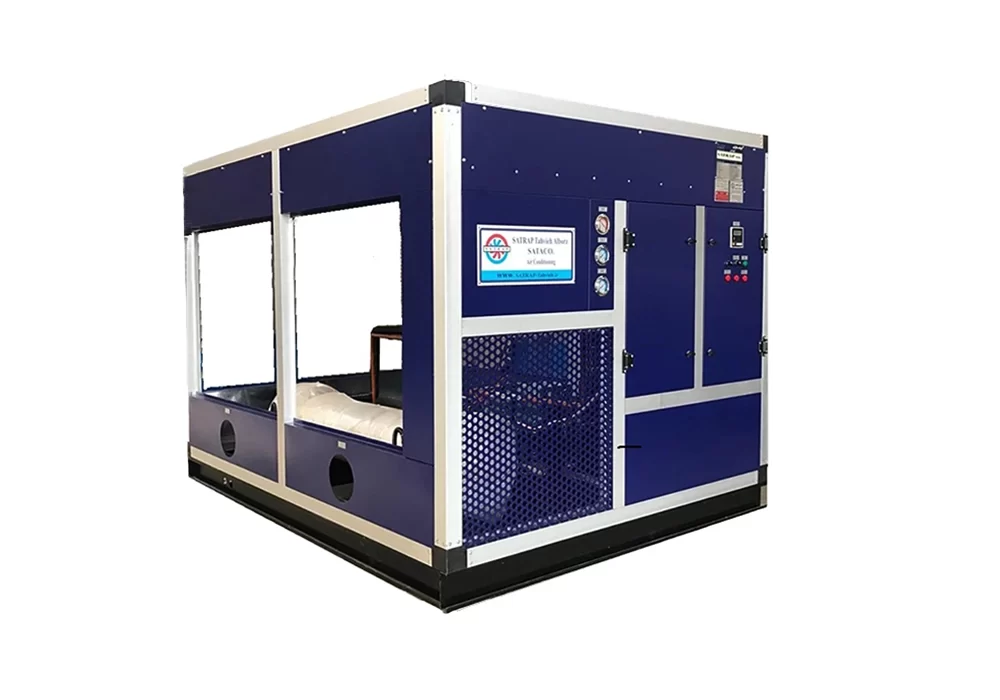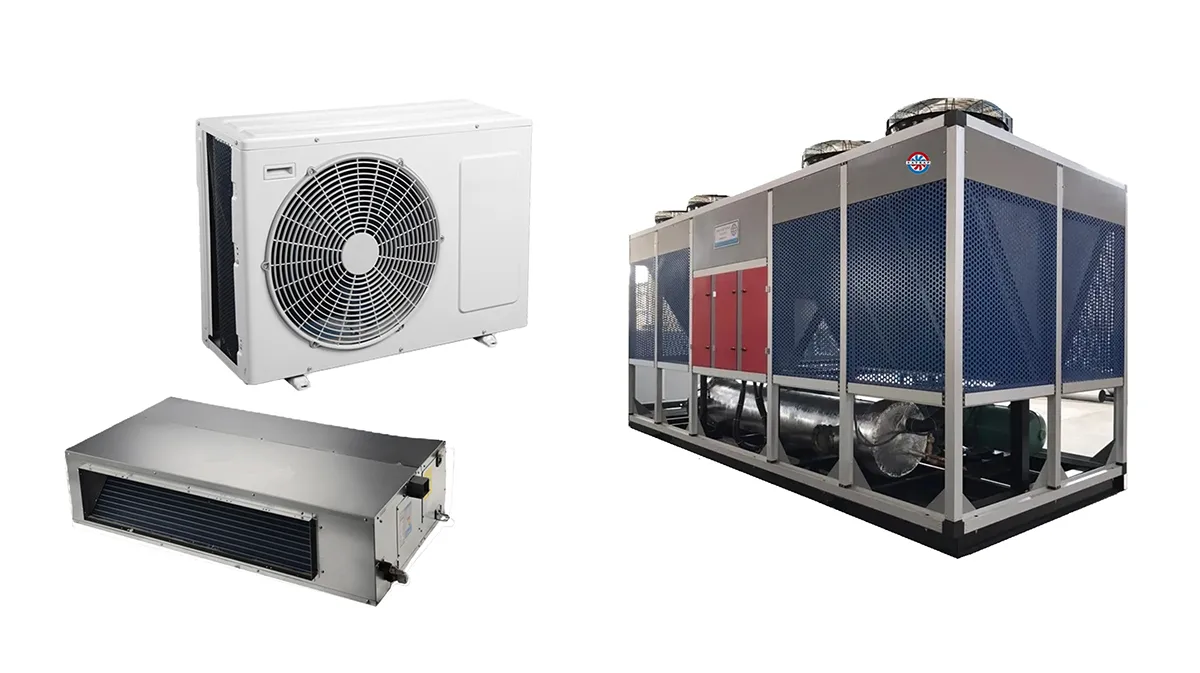What are the differences between a chiller and a ducted split system?
Chillers and ducted splits are two common HVAC systems used for cooling and heating various spaces. Both systems operate on the vapor compression refrigeration cycle, but there are key differences in their structure, performance, and application. This article from Satrap Ventilation Alborz provides a comprehensive overview of these differences.
Structure of Chiller and Ducted Split
Chiller
- Consists of two main units: outdoor and indoor
- Outdoor unit: compressor, condenser, and expansion valve
- Indoor unit: evaporator and fan
- Chilled water produced in the chiller is transferred to the indoor unit by a pump.
- Indoor unit: chilled water flows through the evaporator coil, absorbing heat from the air.
- Air is blown over the coil by the fan, cooling it.
Ducted Split
- Consists of two main units: outdoor and indoor
- Outdoor unit: compressor, condenser, and expansion valve
- Indoor unit: evaporator and fan
- Refrigerant is transferred to the indoor unit through piping.
- Indoor unit: refrigerant flows through the evaporator coil, absorbing heat from the air.
- Air is blown over the coil through ventilation ducts, cooling it.
Performance of Chiller and Ducted Split
Chiller
- Chilled water acts as the heat transfer fluid.
- Chilled water is transferred to fan coils or air handlers.
- Air is blown over the chilled water coil, cooling it.
Ducted Split
- Refrigerant acts as the heat transfer fluid.
- Refrigerant is transferred to the indoor unit through piping.
- Air is blown over the refrigerant coil, cooling it.
Application of Chiller and Ducted Split
Chiller
- Typically used in large buildings such as hospitals, hotels, offices, and commercial centers.
- Suitable for cooling and heating large spaces.
Ducted Split
- Typically used in residential, office, and small commercial buildings.
- Suitable for cooling and heating small spaces.
Advantages of Chiller
- Higher cooling and heating capacity
- Simultaneous cooling and heating capability
- Precise temperature and humidity control
- Possibility of using renewable energy
Disadvantages of Chiller
- Higher price
- Higher installation cost
- Higher noise level
- Requires more space
Advantages of Ducted Split
- Lower price
- Lower installation cost
- Lower noise level
- Requires less space
Disadvantages of Ducted Split
- Lower cooling and heating capacity
- No simultaneous cooling and heating capability
- Limited temperature and humidity control
- Limitations in using renewable energy
Price Difference Between Chiller and Ducted Split
- Chiller is generally more expensive than ducted split.
- This price difference depends on various factors such as capacity, type of chiller, brand, and build quality.
Factors Affecting Chiller Price
- Capacity: Higher capacity, higher price.
- Type of chiller: Compression chillers are cheaper than absorption chillers.
- Brand: Reputed brands are more expensive.
- Build quality: Higher quality, higher price.

Factors Affecting the Price of Duct Split
- Capacity: The capacity of a duct split is determined by the amount of cooling or heating it can produce. The higher the capacity, the higher the price.
- Type: Duct splits are divided into two categories: normal and ducted. Ducted duct splits are more expensive than normal duct splits.
- Brand: The brand of the duct split also affects its price. Duct splits from reputable brands are usually more expensive than duct splits from unknown brands.
- Build quality: The build quality of the duct split also affects its price. Duct splits with higher build quality are usually more expensive than duct splits with lower build quality.
Power consumption of the chiller and duct split
Power consumption is an important factor to consider when choosing an air conditioning system. Power consumption indicates the amount of electricity an air conditioning system consumes to operate.
Chillers
Chillers have a higher cooling and heating capacity than duct splits, so they also have a higher power consumption. The power consumption of chillers varies depending on their capacity, from a few tons to a few hundred tons per hour. For example, a chiller with a capacity of 10 tons per hour has a power consumption of about 100 kilowatts.
Duct Split
Duct splits have a lower cooling and heating capacity than chillers, so they also have a lower power consumption. The power consumption of duct splits varies depending on their capacity, from a few thousand to a few tens of thousand BTU per hour. For example, a duct split with a capacity of 18,000 BTU per hour has a power consumption of about 4 kilowatts.
Comparison of chillers and duct splits in terms of power consumption
Chillers have a higher power consumption than duct splits. This is due to the higher cooling and heating capacity of chillers.
Factors affecting the power consumption of chillers and duct splits
In addition to cooling and heating capacity, other factors also affect the power consumption of chillers and duct splits. These factors include:
- Type of refrigerant
- Compressor type
- Device efficiency
- Climatic conditions
For example, using higher-efficiency refrigerants can help reduce the power consumption of the device. When choosing an air conditioning system, the power consumption of the device should be considered based on the factors affecting it.
Difference between chiller and duct split in terms of capacity
Chillers and duct splits are two common air conditioning systems used for cooling and heating various spaces. Both systems work through the vapor compression cycle, but there are fundamental differences in their structure, performance, and application.
In terms of capacity, chillers have a higher cooling and heating capacity than duct splits. The capacity of a chiller is usually expressed in tons per hour, while the capacity of a duct split is expressed in BTU per hour. For example, a 10-ton chiller can cool the equivalent air volume of 10 tons of water in one hour. While an 18,000 BTU duct split can cool the equivalent air volume of 18,000 BTU in one hour.
Conclusion
Chillers and duct splits are both common air conditioning systems with their own advantages and disadvantages. Choosing the most suitable system for a particular project depends on various factors such as required capacity, budget, building type, and climatic conditions.

